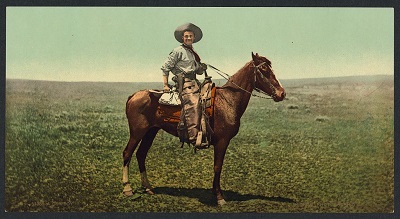National Day of the Cowboy: Remembering the Cowboys Behind the Saga of Lonesome Dove
 Keep your saddle oiled and your gun greased because the “National Day of the Cowboy” – the fourth Saturday in July – is finally here. This day celebrates the lasting legacies of the cowboys that pioneered the American West as they worked cattle, beginning after the Civil War in the heart of Texas.
Keep your saddle oiled and your gun greased because the “National Day of the Cowboy” – the fourth Saturday in July – is finally here. This day celebrates the lasting legacies of the cowboys that pioneered the American West as they worked cattle, beginning after the Civil War in the heart of Texas.
If you’ve read or watched Lonesome Dove then you know the intrepid tale of the two retired Texas Rangers, Augustus "Gus" McCrae and W.F. "Woodrow" Call, who traveled from the Rio Grande in Texas to Montana in the 1870s driving a herd of stolen Texas Longhorns. These two men are the epitome of this holiday and helped define the American cowboy experience. Their story is widely regarded as one of the most realistic portrayals of the Wild West.
It may come as a surprise that this tale of two rugged cowboys that once commanded the Old West was based on a true story that centered around two tough ranchers who charted a slightly different path. Charles Goodnight and Oliver Loving were the original men which inspired the stories of the hard-working Woodrow and outgoing Gus in Lonesome Dove on their famed journey that coined the Goodnight-Loving Trail. Their work would later earn them a spot in the “Hall of Great Westerners” at the National Cowboy & Western Heritage Museum in Oklahoma City.
Like so many good ranchers, both of these brazen Texans had humble beginnings that shaped them to be the trailblazers who we remember on the National Day of the Cowboy.
Charles Goodnight is known as the “Father of the Texas Panhandle” and earned that title for his work as an ambitious cattleman, a Texas Ranger, and veteran of the Civil War. After famously rescuing Cynthia Ann Parker from the Comanches, he went on to invent the chuck wagon during his first cattle drive on the Goodnight-Loving Trail. He later founded the first Texas Panhandle ranch in the Palo Duro Canyon.
His partner Oliver Loving was a skilled rancher and known for being a hard worker. He was commissioned to provide beef to soldiers during the Civil War and by the time General Lee surrendered in 1865, the Confederate Government reportedly owed him over $100,000 for his service. Loving’s legacy lives on through the eponymous Loving County in Texas, the town of Loving in New Mexico, and Loving Bend on the Pecos River.
The two cowboys crossed paths about a year after the Civil War ended. Set on rebuilding their herds after the war, they formed a partnership to drive cattle on the Goodnight-Loving Trail.
Their famed journey began with 2,000 cattle near the headwaters of the Brazos River although in the film and novel, the cowboys begin their ride at the Rio Grande in Texas and finished in Wyoming. From the Brazos they rode southwest to cross the Pecos River at Horsehead Crossing, and then followed the river north to Fort Sumner, New Mexico. The trail continued north through Colorado then finished in Wyoming.
The two men lost a whopping 400 cattle by the end of their first 700 mile trek north, but they still made $12,000 in gold – more than they ever could have earned in the devastated post-war economy of the south.
Part of the Trail took them through the Comanche stronghold in the Staked Plains, near what we know today as Lubbock, and on their third cattle drive in their second year of their partnership, tragedy struck.
Traveling ahead of the herd, Loving and a fellow cow hand found themselves the target of a Comanche attack at Loving Bend on the Pecos River. Fatally wounded by arrows with gangrene, the poison began to set in and Loving scraped his way to Fort Sumner to spend his last hours with Charles Goodnight, his most trusted partner and friend.
Just like in Lonesome Dove, in real life Charles carried out his promise to Oliver that he’d bury him in Texas. On March 4, 1868, Loving was laid to rest at the Greenwood Cemetery in Weatherford, Texas. In the film, Captain famously jokes after the long journey to Texas, “I guess this’ll teach me to be careful about what I promise in the future.”
It is said that even years after Loving’s death, Charles Goodnight carried a photo of his friend wherever he went. Goodnight and other ranchers continued to use the route and it became one of the most prosperous cattle trails of the day.
Today, the trail lives on through Lonesome Dove and the many cattle drives that still take place all over our great state, like the unique, twice-daily cattle drive presented by the Fort Worth Herd at the Stockyards and the Longhorn Cattle Drive that’s a part of the annual Cowboy Capital Parade in Bandera, Texas.
If you haven’t already, take the time to read a classic western novel in the late Texas author Larry McMurtry’s honor and learn firsthand what the tough and hardworking individuals we call cowboys were really like.
As Gus McCrae would say, “the older the violin, the sweeter the music” and the same idea applies to these timeless tales.



